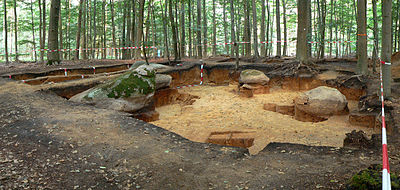Linsburg stone grave
The megalithic grave Linsburg is an incompletely preserved Neolithic stone grave in Grinderwald in the municipality Linsburg in Lower Saxony . The time of origin of the grave complex is estimated at around 3500 BC. Estimated.
Location and description
The megalithic grave is located about 3.5 kilometers southeast of Linsburg, one with a book -lined Forestry Department of Forest Grinder. The stones of the grave have long been known in the area. The place has been called "near the five stones" since ancient times. In the vicinity there is another large stone grave from the Neolithic Age, the Devil's Bed at Stöckse . Viewed over a large area, the two stone graves are located in the district of Nienburg in the border area between the Funnel Beaker and Michelsberg cultures , as shown by the results of the archaeological investigations on the earthworks of Müsleringen .
Originally the grave complex probably consisted of eight large boulders , of which five of the stones are still present and visible on the surface. They are protected as natural monuments . These are ice-age boulder blocks that were aligned parallel in a north-south direction. After the First World War , a large stone from the facility was transported to Linsburg with the help of a tractor . It was erected in 1921 in the center of the village on the Schulberg as a war memorial and bears the names of 33 soldiers from Linsburg who died in the First World War. The whereabouts of two other large stones in the grave complex is unclear.
excavation
The first archaeological study of the Linsburg stone grave was carried out by students from the Department of Prehistoric and Protohistoric Archeology at the University of Hamburg under the direction of archaeologist Britta Ramminger in August 2015. The training excavation , which lasted several weeks, took place on an area of 60 m² in the area of the five large stones. The finds so far from the excavation, which was completed at the end of August 2015, include a ceramic piece and charcoal fragments that provided evidence of a fireplace. The archaeological findings include footprints from large stones. After the investigations, it is planned to make the grave complex accessible to the public through a circular path and an information board.
See also
- List of natural monuments in the district of Nienburg / Weser
- List of large stone graves in Lower Saxony, Bremen and Hamburg
literature
- Historical overview - The First World War In: 800 years Linsburg . Municipality of Linsburg, Linsburg 2003, OCLC 255138655 , p. 27-28 .
- The local legends In: 800 years of Linsburg . Municipality of Linsburg, Linsburg 2003, p. 105 .
Web links
- Academics get their hands dirty. In: Kreiszeitung from August 4, 2015
- Megalit grave testimony to the first farmers in the district. In: Die Harke from August 4, 2015
- Family crypt? Ossuary? Archaeologists in the Grinderwald in: Steimbke Magazin issue no.16 from November 2015, p. 2 (pdf, 6 MB)
Individual evidence
- ↑ Susanne Döpke: Researchers unearth the Hünengrab in: Schaumburger Nachrichten of August 27, 2015
- ↑ Stefan Reckleben: Where hunters and gatherers settled in: Die Harke from August 14, 2015
- ↑ Directory of natural monuments in the district of Nienburg / Weser ( Memento from September 29, 2015 in the Internet Archive ) (PDF, 47 kB); accessed on August 17, 2015
- ^ The First World War in: Die Linsburger Chronik , on gemeindelinsburg.de
- ↑ Stefan Reckleben: On the trail of Grinderwald's great, great people. In: Die Harke from August 14, 2015
Coordinates: 52 ° 34 ′ 30 " N , 9 ° 20 ′ 38.4" E



